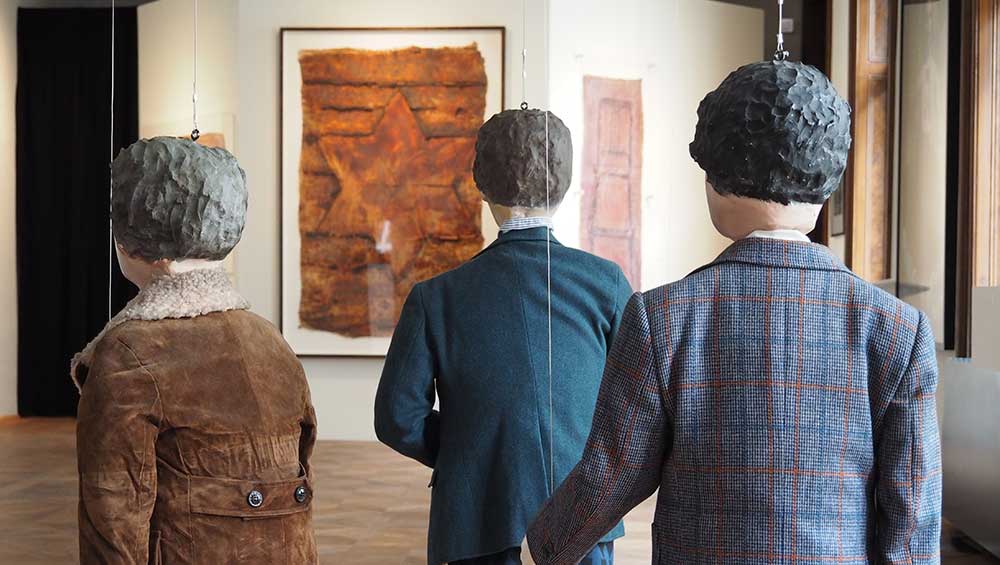
The Uncanny: Sigmund Freud and Art, installation view, The Sigmund Freud Museum, Vienna. © Stephani Lletofsky.
The Sigmund Freud Museum, Vienna
26 April – 4 November 2024
by CHRISTIANA SPENS
The former residence of Sigmund Freud and his family, Berggasse 19, is now a typical tourist pit stop for those visiting Vienna, with Cafe Freud open next door for refreshments, and a little gift shop selling mugs with an image of Freud and the words I LOVE MUM among other delights. Upstairs, each room is educational, with various exhibits of original books and documents, photographs and, of course, the original couch where Freud’s patients would once have complained about their various neuroses. And then, through a very narrow, almost hidden little door, there is a room containing artefacts that, at first glance, seem strikingly out of place. Although there is nothing clearly signposting that this is an exhibition of contemporary art on the theme of “Das Unheimliche,” the various works immediately give a sense of quiet, skin-crawling horror.
This is all very fitting, of course. Das Unheimliche is generally translated into English as “the uncanny”, but it is more literally translated as “the unhomely”. This compelling emotional state that once aroused Freud’s interest has been explored in the realm of visual art ever since he conceived of it, and indeed even before he articulated his famous theory. The tension between the home and the strangeness that may imbue it and so disturb us had been a point of fascination in Gothic horror for centuries. Elsewhere in Freud’s old home (above a desk, by the famous couch), there is a reproduction of Henry Fuseli’s painting The Nightmare(1790-91), in which a woman lies rapturously and receptively on a bed as an incubus sits on her chest and a horse emerges from her bedroom curtains. Revealing an interior world of subconscious erotic obsession and infatuation, this was a Romantic exploration of repressed desire and dreams, which inspired Freud’s later theorisation. The woman is in a sort of sleep, or delirium, captivated by a haunting, impish, and yet domineering demon; the visual expression of such a state brings to light the dark, secret corners of the human psyche, which psychoanalysis also brings forth in a more dogmatic and practical manner. The uncanny, Freud found, was “in reality nothing new or foreign, but something familiar” that “has been estranged only by the process of repression”. It is the estranged familiar.
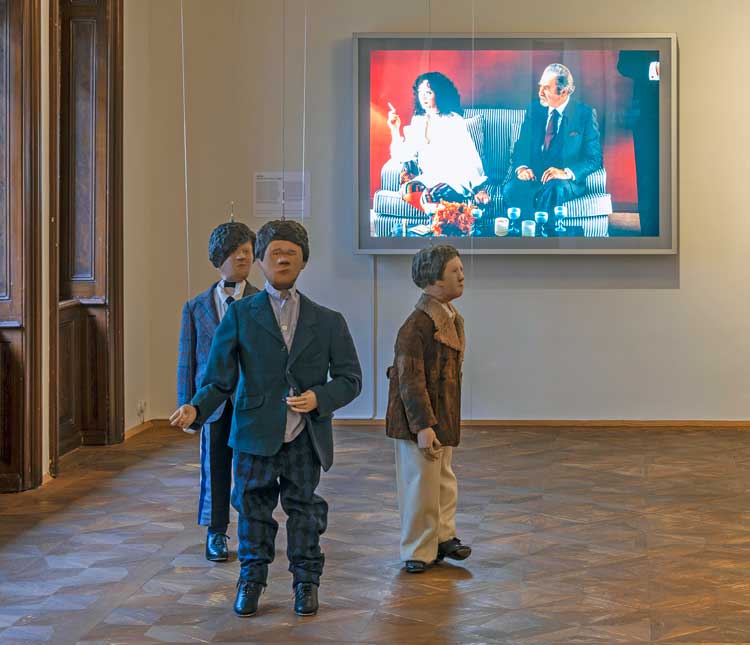
Markus Schinwald, Misfits (foreground); Jeff Wall, A Woman and her Doctor. © Oliver Ottenschlaeger.
The home, and Das Heimlich, is central to Freud’s theorisation and practice of psychoanalysis. As we can see in the museum itself, Freud received his patients in his own home, as many psychoanalysts do today, and much of analysis itself is concerned with the family home, one’s memories of it, and how those memories seep into our present minds and newer homes. The uncanny or unhomely is precisely the sensation of strangeness within one’s home, a jarring co-existence between being at home, and something ambiguous and outside (and yet also, so often, from deep within) bleeding into one’s present state. The eerie, dislocating sense of Das Unheimliche – a feeling of both familiarity and unease – lies in a dissonance with the home and the family, who may or may not physically be there. This state reveals, on further probing, tensions about belonging, attachment and how we continue to organise our lives and identities around that past place, those early childhoods, those repressed figures we are from.
What is especially interesting about visiting an exhibition on this subject in Sigmund Freud’s family home of 47 years is that it is, in a way, an exhibition hidden within an exhibition. The museum is already uncanny by virtue of the absence of Freud and his family, who once lived there and now leave only traces. Now, curated by Monika Pessler and Dr Nicole Fritz in cooperation with Kunsthalle Tuebingen, this special exhibition of provocative contemporary art in one corner of the house creates a heightened sense of a pre-existing mild horror, perhaps especially because the family originally left this home, and Vienna, to escape the horrors of nazism. The empty family home, where psychoanalysis itself was conceived, now feels compellingly hollow– and uncanny – on account of the presence of these ghosts, and their ghosts, too. It is a microcosm of Das Unheimliche, and the exhibition takes on the role of that nightmare demon resting on one’s chest as we sleep fitfully, between consciousness and sleep, hidden in a corner of the family home.
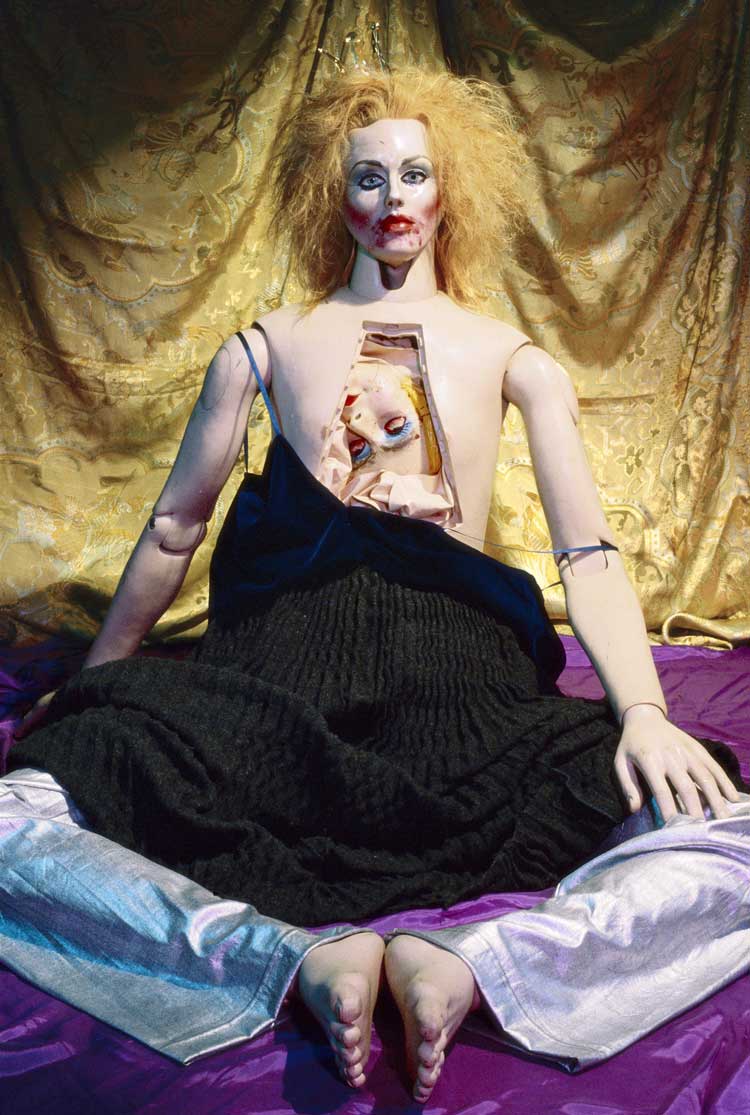
Cindy Sherman. Untitled #302, 1994 Chromogenic Color Print. © Cindy Sherman. Courtesy the Artist and Hauser & Wirth.
This little demon has various guises in these forms of contemporary art: the works on display confront the uncanny in metaphorical compositions of deformed and exposed bodies, as well as subtle compositions that gradually reveal states of delirious horror in our inescapable domestic worlds. In some of the works, this sense of familiar horror is particularly tied to the female body; in Cindy Sherman’s Untitled #302 (1994), there is a broken mannequin, with another mannequin head in its chest cavity, its lap covered with a black cloth that creates a disconcerting void. In a 2005 edition of a photograph from Francesca Woodman’s Boulder, Colorado, 1972-75,series, Woodman is sitting against a wooden wall, her torso bare, with clothes pegs clipped to her nipples and stomach, her palms on her thighs, in an image that is confrontational as well as recalling religious icons of martyrdom such as Saint Sebastian. There is a sense of not being able to be at home, or comfortable, in one’s own body on account of it being haunted by male violence and propriety, and Woodman very simply communicates the physical, emotional state that arises from wider violence and threat. Her vulnerability is brazen: it is both mundane and erotic. There is also a humorous element; that clothes pegs, and perhaps the act of putting up laundry, should be so painful, and yet the artist endures.
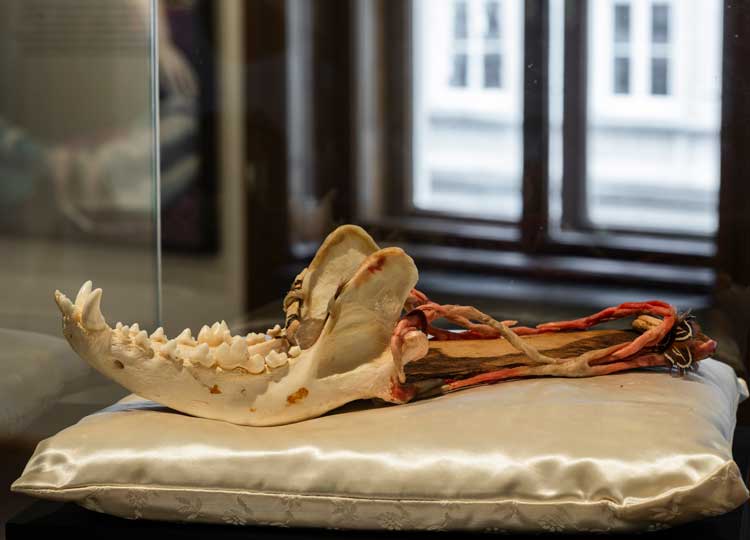
Birgit Jürgenssen. Relikteschuh (Relic Shoe), 1976. © Oliver Ottenschlaeger.
In Relikteschuh (Relict Shoe) from 1976, Birgit Jürgenssen presents what is left of a shoe, with a bloody footprint on yellowed leather, framed in a jawbone. There is something delicate and somehow luxurious about this strange, constructed object, a fetishised thing taken to its logical conclusion perhaps, the foot no longer there at all; decadence has fallen to decay and it is preserved there. Jürgenssen’s polaroid Freud’s Couch (1975) is also here, showing the artist’s divan as connected to the psychoanalytical setting, and revealing how her own home, her bed, has become a site of introspection, perhaps revealing that she cannot escape her own introspection, and that now psychoanalysis haunts her home too. As Julia Kristeva wrote in Strangers to Ourselves, “With Freud indeed, foreignness, an uncanny one, creeps into the tranquillity of reason itself … Henceforth, we know that we are foreigners to ourselves, and it is with the help of that sole support that we can attempt to live with others.”
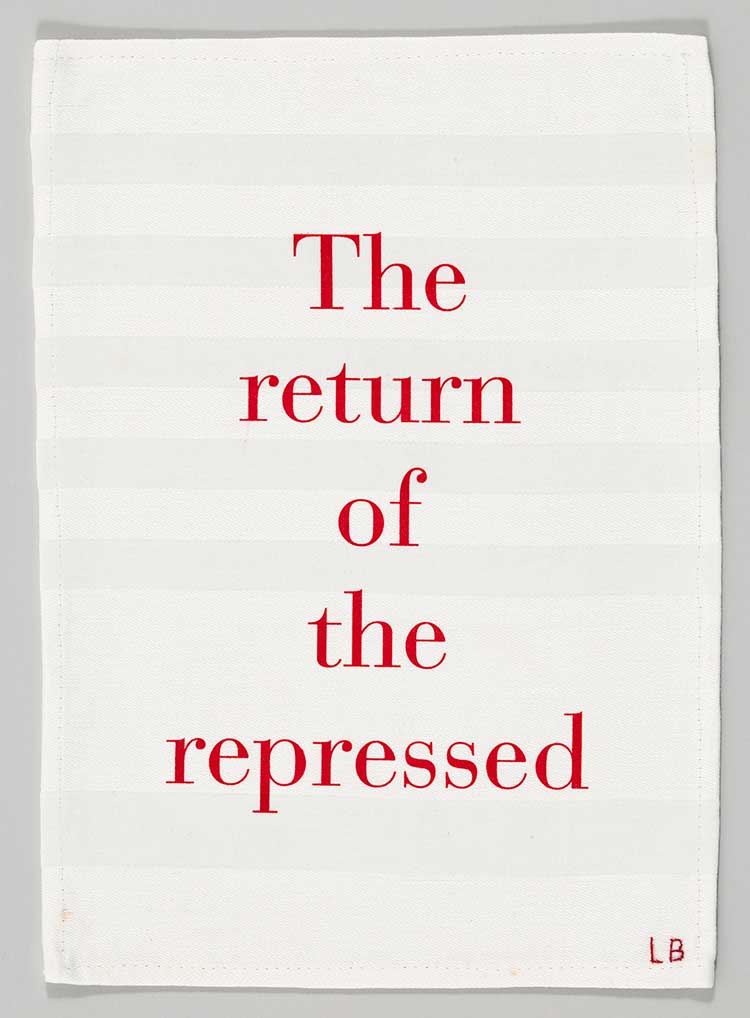
Louise Bourgeois. The Return of the Repressed, 2002. © The Easton Foundation / Bildrecht, Vienna 2024.
In seeing these artistic expressions of this alienating and yet shared state, borne of similar human experiences, there is certainly a sense of the necessity of other people’s perspectives and shared experiences so that we may understand ourselves and connect to others, too, thus diminishing the weight of alienation. By integrating the others who might otherwise repel us, at least momentarily we may find some peace from a sense of strangeness. Louise Bourgeois’s 2002 lithograph states, quite cheerfully, THE RETURN OF THE REPRESSED; among these other, more horrifying works, this is a reminder of the everyday nature of such horrors, and indeed the psychoanalysis that might bring them to the fore and perhaps even diffuse them.
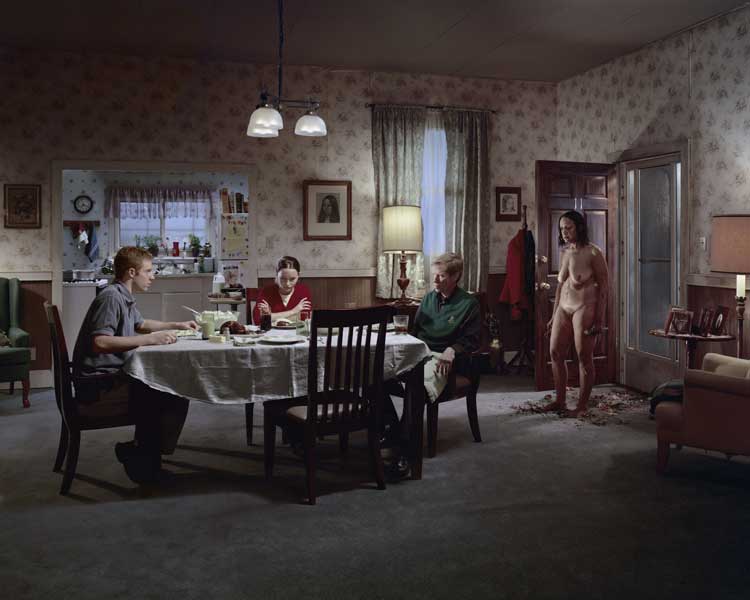
Gregory Crewdson. Untitled 1998-2002, Digital pigment print, image size 48 x 60 In. © Gregory Crewdson.
Elsewhere in the exhibition, Markus Schinwald’s Misfits (2013) features child-sized puppets, with their haunting little faces jerking on their strings in a jarring, mechanical routine recalling Freud’s writing about the effect of animistic animated things in his 1919 text The Uncanny. There is also Gregory Crewdson’s photographic tableau from the series Twilight (2001-02), which shows an average American family at dinner, though the mother stands in the doorway naked, dishevelled and yet unnoticed. The mother, or rather her potentially monstrous, sexualised self, lies in wait – unseen by the rest of the family and yet on the verge of upending any order or “normality” that the typical dinner scene might otherwise uphold. In Jeff Wall’s photograph A Woman and Her Doctor (1980-81), it is unclear what exactly the relationship is between them, though in her turning away from the doctor, as he remains focused on her, there is a sense of mismatched attention and the tension that brings with it. Whatever conflict lies between them, to the viewers it is a secret one. In Helmut Newton’s photograph Pierre and Denise Klossowski (1986), the writer and his wife are in their Paris apartment, recreating scenes of seduction in a psychoanalytical setting, and alluding to Pierre Klossowski’s novel The Laws of Hospitality (1965) for some transference drama, and indeed humour; as in classical analysis, all eye contact is avoided in order to devote full attention to spoken or heard words. Indeed, there is a sense with all these works of encroaching on someone else’s private drama; the art opens it up but only so much, and the tension of its secretiveness is palpable. Perhaps, in this tension, we gain some insight into the experience of the analyst, too.
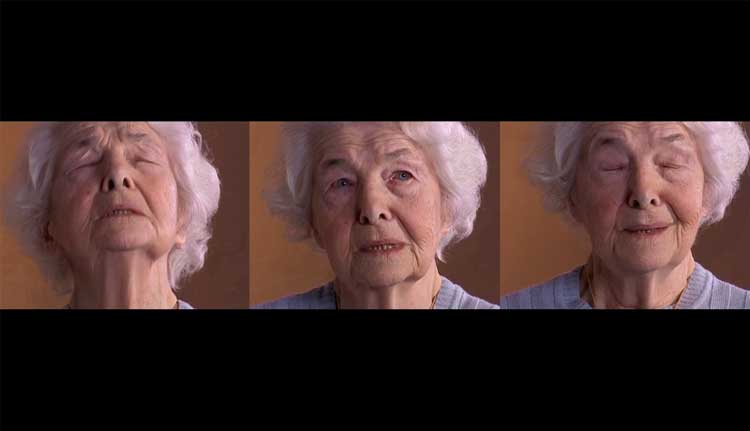
Esther Shalev-Gerz, Between Listening and Telling, 2005 (Still).
There is also horror that feels repellent in its severity; in her 2005 video Between Listening and Telling, Esther Shalev-Gerz recorded the reactions of survivors of the Auschwitz-Birkenau concentration camp that were revealed on their faces during interviews. I cannot help but feel that perhaps the video, and we, are intruding on private trauma as we try to understand it, and inevitably these images stay with me long after I have seen them. What I find interesting about something so intentional as an exhibition on the Uncanny is that it creates this shared experience and shared memories about the private lives of others that we would not otherwise have; even if there were no communal unconscious, art creates it in spaces like this, even though it may waver close to voyeurism and intrusion as it meets psychoanalysis and probes the suppressed pain of other people.
Back in London, there is another Freud Museum, this time his family’s old home in Hampstead, boasting a second iconic couch, as well as a new replica of that, too, borrowed from the film set of Freud’s Last Session (2023), starring Anthony Hopkins as Freud. There is something uncanny about viewing the iconic couch and other remnants of Freud’s life in this way. We all crave familiarity, however disturbing (and uncanny) that may be; in seeing exhibition after exhibition, and couch after couch, I begin to feel very at home with these props of psychoanalysis. There is something moving in the existence of a second Freud Museum; despite displacement, the family found a new home, even if it is slightly haunted by the old one, and the old world once around it. I do also wonder what Freud would have made of his family homes being transformed into museums all these years later, visited by tourists on their little pilgrimages, as well as students of psychoanalysis, leaning into the temptation to fetishise. But perhaps he would not be surprised. Freud remains a ghost very welcome in his own home(s), where others, though more obviously of this world, merely pass through, keeping the channel to the past and our deeper selves open. Perhaps that is just how he would have liked it.